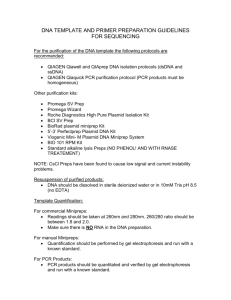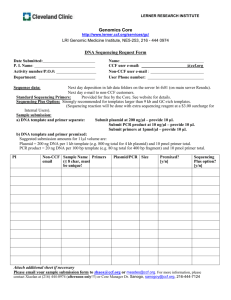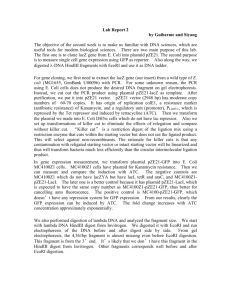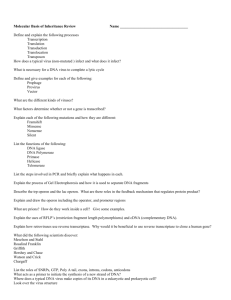Primer Design and Sequencing
advertisement
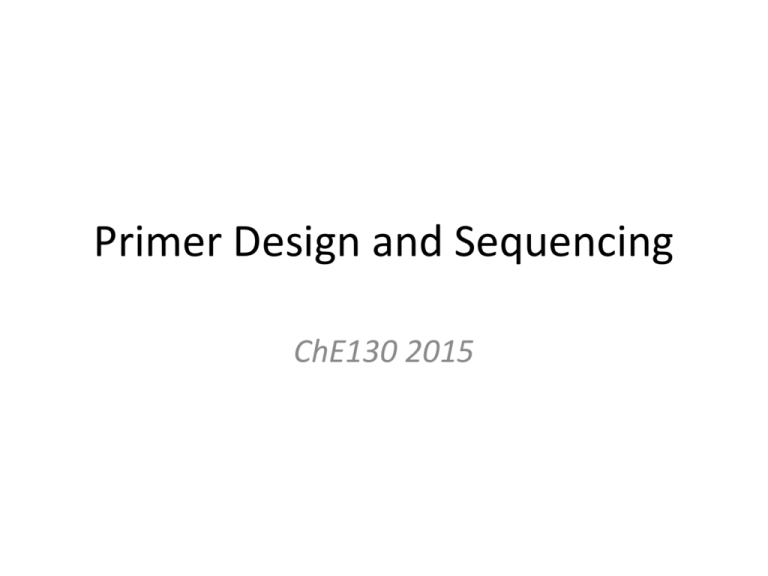
Primer Design and Sequencing ChE130 2015 General Rules • Sterile technique!! • Report any problems to TAs ASAP (and in advance if possible) – Supply concerns (plates, media, tips, tubes, etc.) – Bad reagents • Take good notes – This is critical for troubleshooting; help us help you. • Cleanliness – Keep enzymes (2X Pfu, 2X Paq, Restriction Enzymes, Ligase, Phosphatase) on ice and put them away immediately after using them. – Double-check your work area before leaving • • • • • • Tips, etc in Biotrash Dump liquid waste in fume hood Gels in trash, pour running buffer into the bottle, rinse / dry running apparatus Return materials to their proper locations Turn off all machines (NanoVue, Gel Runners) Don’t leave lids open 2 Primer Design 3 Primers are short synthetic ssDNA or oligonucleotides that serve as starting points for DNA synthesis “Forward” Primer: 5’ – GCCAGGAGTGAAACGATG – 3’ pYPET Template DNA: 5’ – GCCAGGAGTGAAACGATGTCTAAAGGTGAAGAATTATTCACTGGTGTTGT — 3’ 3’ – CGGTCCTCACTTTGCTACAGATTTCCACTTCTTAATAAGTGACCACAACA — 5’ Denaturation Annealing 5’ – GCCAGGAGTGAAACGATG — 3’ 3’ – CGGTCCTCACTTTGCTACAGATTTCCACTTCTTAATAAGTGACCACAACA — 5’ Elongation 5’ – GCCAGGAGTGAAACGATGTCTAAAGGTGAAGAA — 3’ 3’ – CGGTCCTCACTTTGCTACAGATTTCCACTTCTTAATAAGTGACCACAACA — 5’ 4 Primers are short synthetic ssDNA or oligonucleotides that serve as starting points for DNA synthesis “Reverse” Primer: 5’ – GCCACCTTGGCCTTAGTG – 3’ 3’ – GTGATTCCGGTTCCACCG – 5’ pYPET Template DNA: 5’ – TGAATGAATTGTACAAACACCACCACCACCACCACTAAGGCCAAGGTGGC — 3’ 3’ – ACTTACTTAACATGTTTGTGGTGGTGGTGGTGGTGATTCCGGTTCCACCG — 5’ Denaturation Annealing 5’ – TGAATGAATTGTACAAACACCACCACCACCACCACTAAGGCCAAGGTGGC — 3’ 3’ – GTGATTCCGGTTCCACCG — 5’ Elongation 5’ – TGAATGAATTGTACAAACACCACCACCACCACCACTAAGGCCAAGGTGGC — 3’ 3’ – GTGGTGGTGGTGGTGGTGATTCCGGTTCCACCG — 5’ 5 Guidelines for Primer Design • Length • Melting Temperature – %GC Content • • • • • Primer pair (length and Tm) 3’ GC Clamp Extra nucleotides for restriction enzymes No secondary structures Avoid cross-homology 6 Guidelines: Length • Binding region (18-25 base pairs) – A tradeoff between specificity and annealing • Oligonucleotide synthesis are 99% efficient – Max primer length will be 60bp Length % of Primers w/Correct Sequence 10 bases 20 bases 30 bases 40 bases 50 bases (0.99)10 = 90.4% (0.99)20 = 81.8% (0.99)30 = 74.0% (0.99)40 = 66.9% (0.99)50 = 60.5% 7 Guidelines: Melting Temperature (Tm) • Tm is the temperature at which 50% of the primer-target duplex dissociates • Related to annealing temperature (Ta) for PCRs – Aim for Ta = 55-60°C, which corresponds to Tm = 60-65°C • Many online calculators Can share PCR blocks if using the same PCR program! – Built-in to plasmid editors – Online: http://www.idtdna.com/analyzer/Applications/OligoAnalyzer/ • GC content 40%-60% 8 Guidelines: Primer Pair • Forward and reverse primers should have similar length and Tm to: – Avoid preferential amplification – Simplify PCR optimization • Aim for: – Differences in length < 3 bases – Differences in temperature < 3°C Example, pYPet primers: 5’ – GCCAGGAGTGAAACGATG – 3’ 5’ – GCCACCTTGGCCTTAGTG – 3’ Forward Primer: 18nt, Tm = 53.5°C Reverse Primer: 18nt, Tm = 56.2°C |Δlength| = 0 |Δtemperature| = 2.7°C 9 Guidelines: Other Considerations • 3’ GC Clamp – The presence of a G or C at the 3’ end promotes correct binding due to the stronger hydrogen bonding of G and C bases • Avoid runs and repeats Restriction Endonuclease – Misprime – Errors in synthesis • Extra nucleotides for DNA restriction enzyme (endonucleases) digestions PDB: 1RVA 10 pZE_Plac-YPet Sequencing primer will be provided for everyone General Workflow 1. Use pZE_Plac-Ypet as both your template DNA and as your plasmid backbone 7 BamHI (1) lac promoter 38..78 100 EcoRI (1) RBS 110..122 121 KpnI (1) seq_fwd 2886..2905 2. Design primers to amplify Promoter and RBS region YPet 127..861 AmpR 2800..1940 pZE_Plac-YPET 3005 bp 862 HindIII (1) T1 893..936 seq_rev 1107..1088 T0 1827..1853 3. Use restriction enzyme (RE) sites (BamH1, EcoR1, Kpn1, or HindIII) Note: these sites are unique, double digest compatible and give ‘sticky ends’ 4. Create designed plasmid through ligation at RE sites colE1 996..1803 lacI binding site colFWD RBS lac promoter BamHI -35 box Seq FWD -10 box colREV1 EcoRI KpnI colREV2 YPET HindIII 11 Possible Cloning Strategies RBS Modifications 1 RBS lac promoter BamHI 2 -35 box -10 box EcoRI BamHI -35 box -10 box EcoRI HindIII KpnI RBS lac promoter YPET KpnI YPET HindIII 12 Possible Cloning Strategies Promoter Modifications Changes in the -35 box 3 RBS lac promoter BamHI 4 -35 box -10 box EcoRI BamHI -35 box -10 box EcoRI HindIII KpnI RBS lac promoter YPET YPET HindIII KpnI BamHI EcoRI Changes in sequence 13 Possible Cloning Strategies Other Methods QuickChange NNNNNN 5 RBS lac promoter BamHI -35 box -10 box EcoRI YPET HindIII KpnI NNNNNN Error-Prone PCR BamHI 6 RBS lac promoter BamHI -35 box -10 box EcoRI KpnI YPET HindIII 14 Sequencing 15 How does sequencing work? Plasmid DNA sample Sequencing primer is located ~100bp upstream of segment to be sequenced • Sequencing results are not accurate within the first 100bp region • Accuracy also tapers off after 800900bp 16 Sequencing Plasmid DNA • Miniprep overnight culture of cells harboring desired plasmid • Measure concentration of plasmid DNA – Check A260/280 – Verify samples are plasmid DNA • Carefully label tubes for samples to be sent for sequencing – At least 400 ng of plasmid – 10 µL of 10 μM sequencing primer • If submitting more than 3 sample, add 2μL sequencing primer for each additional sample • Prepare online form – Enclose tubes and printout in a plastic bag • Dropbox will be located outside of Braun 16/17 – Pickup is at 1pm for Retrogen – Pickup is at 9am and 3pm for Laragen 17 But before you sequence… • Verify plasmid DNA is plasmid DNA and contains insert of correct length – Colony PCR – Restriction mapping – DNA gel electrophoresis +Insert seq_fwd 2886..2905 7 BamHI (1) lac promoter 38..78 100 EcoRI (1) RBS 110..122 121 KpnI (1) No Insert YPet 127..861 AmpR 2800..1940 pZE_Plac-YPET 3005 bp 862 HindIII (1) T1 893..936 seq_rev 1107..1088 T0 1827..1853 DNA gel colE1 996..1803 18 Go to http://sequencing.retrogen.com Or: http://sequencing.laragen.com/ 19 Home Screen 20 Submit sequencing requests - Retrogen 21 Submit sequencing requests - Laragen 22 Home Screen 23 Results, next morning by 10am 24 DNA editing software Key features: restriction site recognition, DNA annotations • ApE (A plasmid Editor) – OS X and Windows http://biologylabs.utah.edu/jorgensen/wayned/ape/ • pDRAW32 – Windows only http://www.acaclone.com/ 25

